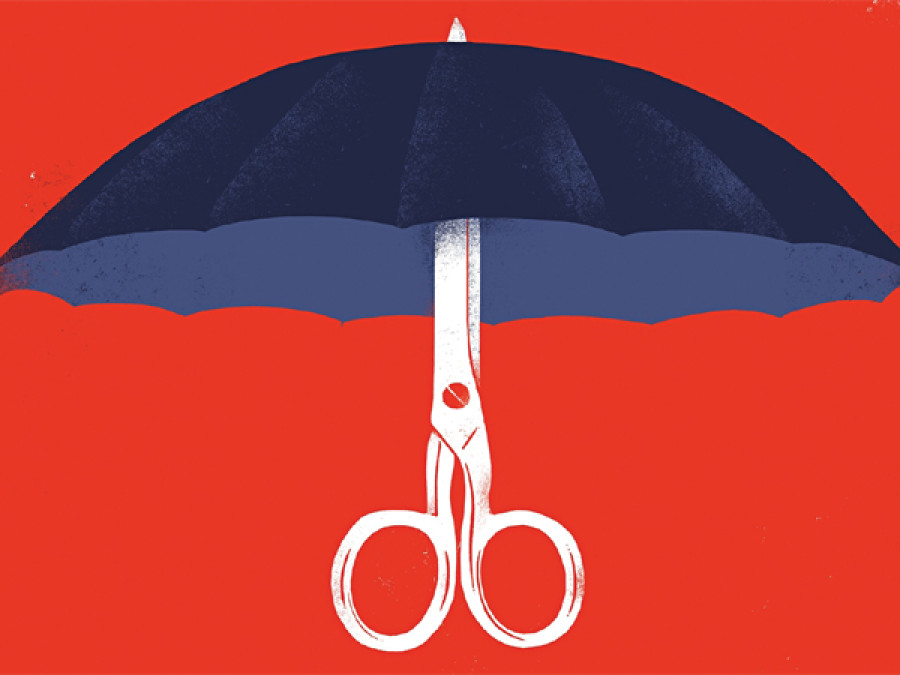Opinion
The long wait
Seven months have passed since the quake, but the victims are yet to be rehabilitated
David Kainee
Nepal is the 11th most earthquake-prone country in the world. In 1934, the country was struck by an 8.4 magnitude earthquake which killed nearly 10,000 people. Even though Nepal is so vulnerable to natural hazards, there was no serious preparedness among governmental and non-governmental agencies before Nepal was struck by the 7.6 earthquake in April which killed nearly 9,000 people and destroyed around half a million homes. If the government had been prepared and life-saving drills had been conducted, possibly we could have averted this massive loss. This is the only reason why there is minimum loss of lives and property when high-magnitude earthquakes jolt Chile and Japan, two most earthquake-prone countries in the world. Nepal failed completely during the preparedness stage, and now it has performed even more badly during the rehabilitation and reconstruction stage. Seven months have passed since the disaster, but the quake victims who battled the monsoon under flimsy tarpaulin tents have still not been rehabilitated.
Government’s failures
In the immediate aftermath of the quake, many youths rushed to the affected districts with some relief materials to serve the earthquake victims. During that period the quake victims were living under the open sky due to lack of tarpaulin sheets. Their suffering moved the youths to help generously. Nepali youths stepped forward as frontline responders. Even the United Nations Development Programme (UNDP) also praised Nepali youths for their post-quake volunteerism. “This base of volunteerism made a tremendous impact on the earthquake response,” said the UNDP to commemorate the service of Nepali youths on the occasion of International Volunteer Day. Even though there was poor coordination between organisations and government agencies in relief distribution, help reached to the affected people. But the government of Nepal, which should have led the rehabilitation and reconstruction effort, was the worst performer.
Nepal organised an International Conference on Nepal’s Reconstruction after doing a Post-Disaster Need Assessment (PDNA) where donors pledged around Rs 410 billion in aid. But due to bickering between the Nepali Congress (NC) and the CPN-UML over the formation of the National Reconstruction Authority (NRA) and the appointment of its Chief Executive Officer (CEO), the government has been able to sign agreements for merely 13.65 percent of the total assistance. Apart from distributing Rs 15,000 each to earthquake victims, the government has done nothing in the last seven months. For the winter season, the government has promised to dole out another Rs 10,000 each to the victims. It seems that the government is still in the relief distribution phase of the disaster when it should have already finished rehabilitation and reconstruction. Only Rs 17 billion out of the Rs 91 billion set aside for the reconstruction authority has been approved. The remaining Rs 74 billion has not been allocated to any ministry.
Increasing impediments
Moreover, the ongoing undeclared Indian blockade has slowed down reconstruction and rehabilitation of earthquake victims. Lack of construction materials and skyrocketing prices of daily commodities have further increased their plight. Whatever help the Indian government had provided during the earthquake relief phase through its Operation Maitri has been lost due its inhumane economic embargo against Nepal. To speed up rehabilitation and reconstruction, the blockade should be lifted as soon as possible on humanitarian grounds.
The appointment of the chief of the proposed NRA has been a bone of contention between the NC and the UML. The NC wants Govind Pokhrel to continue as the CEO while the UML wants to appoint a new head according to a new act passed by Parliament. The dispute over the CEO’s post has pushed rehabilitation and reconstruction into the background. The major parties should sort out this issue immediately in the spirit of consensus. Due to the absence of the NRA, no deal has been signed with donors including India and China, and this has severely hampered the work of rehabilitation and reconstruction.
Get on with it
When millions of people are still languishing inside tarpaulin tents even seven months after the earthquake, rehabilitation and reconstruction should be given priority over petty politics. The government should immediately table an ordinance on the NRA at Parliament. The NRA, which timed out since Parliament did not pass the bill, should be revived and its CEO appointed in the spirit of consensus. Then bilateral agreements should be signed with the countries which have pledged support. Rehabilitation and reconstruction should be done on a war footing. The loan procurement process should be move forward. NGOs and INGOs should work in close coordination with government agencies to avoid duplication of efforts.
The devastating earthquake jolted Nepali leaders into finishing the long-running task of writing the constitution. When not a single word of the document was written in the last eight years, the deadly quake galvanised them into action. The earthquake victims had expected that the government would accord priority
to the NRA now that the constitution has finally been completed, but endless differences between the political parties have left reconstruction and rehabilitation in limbo, which is very unfortunate.
Kainee is associated with Global Hope Network International




 10.12°C Kathmandu
10.12°C Kathmandu











